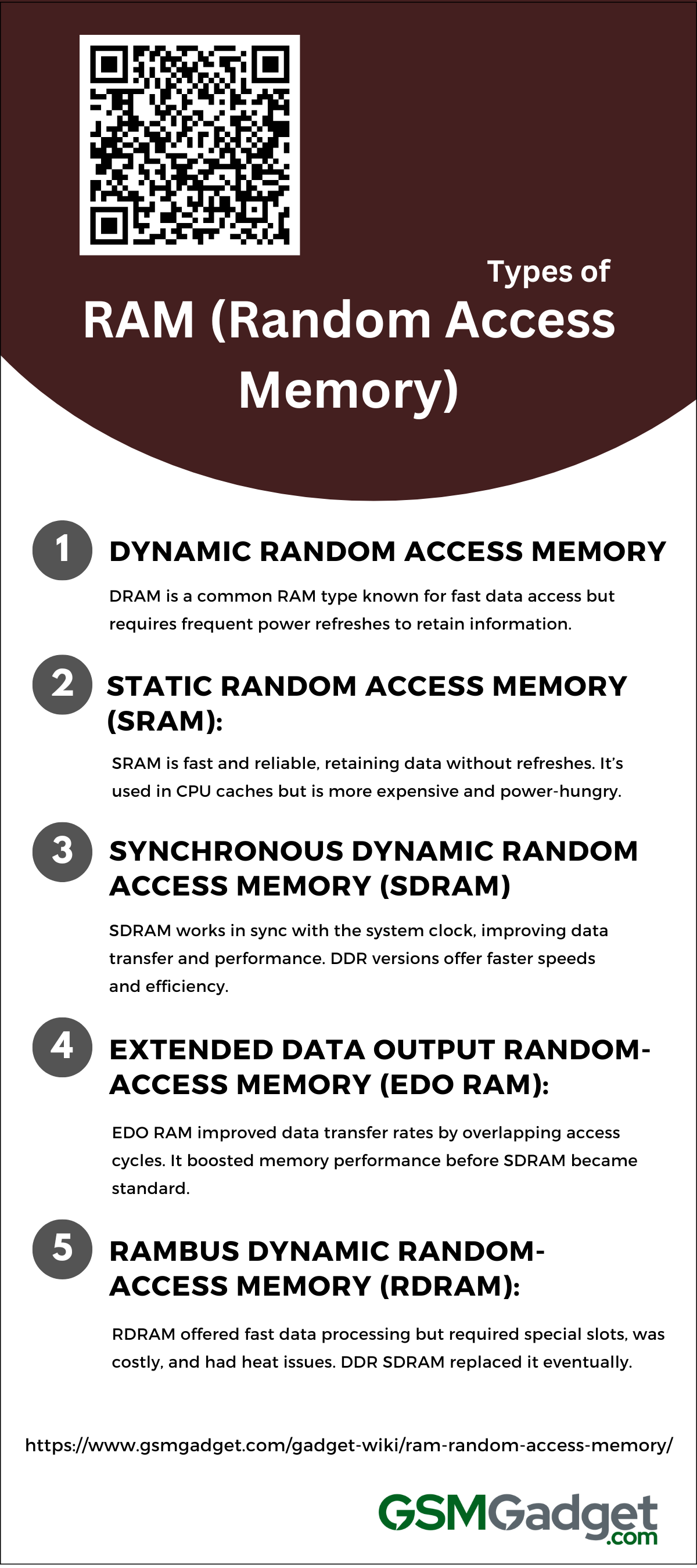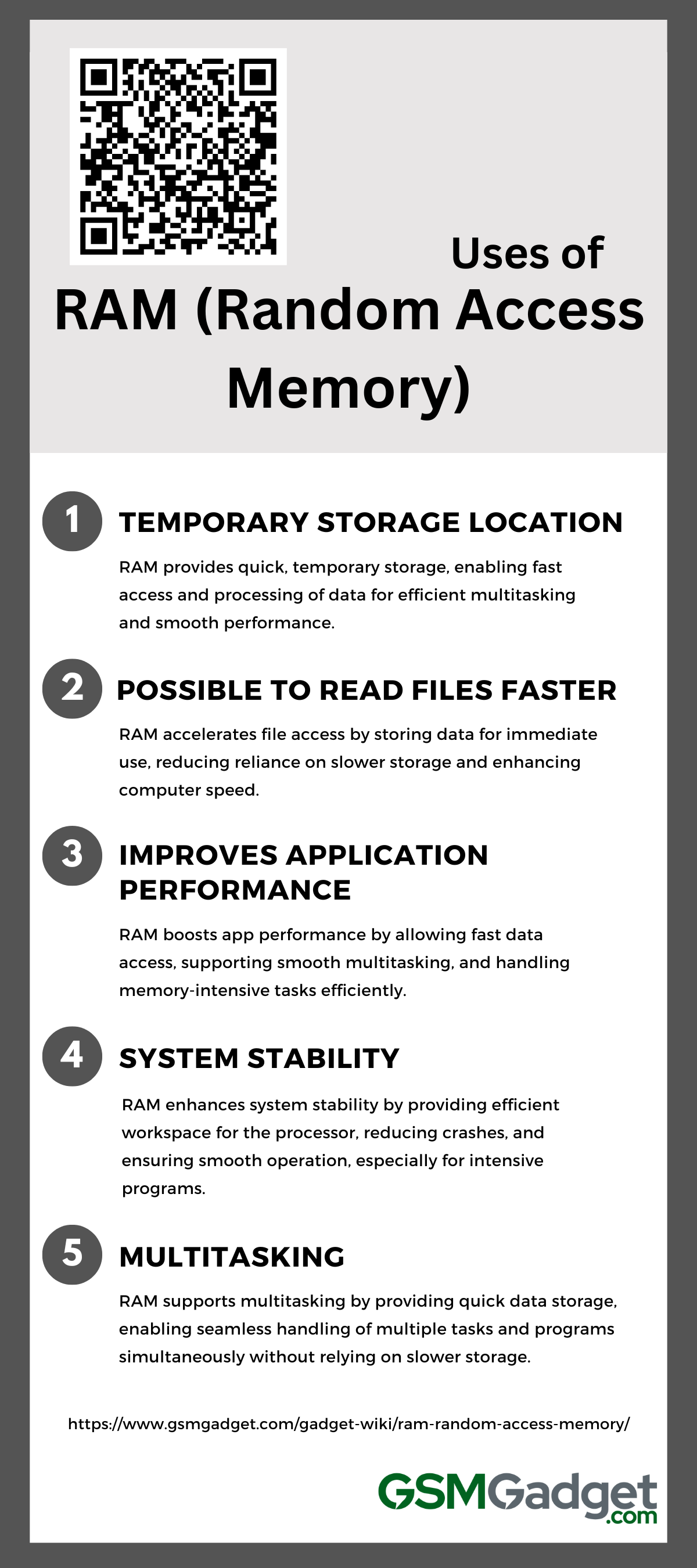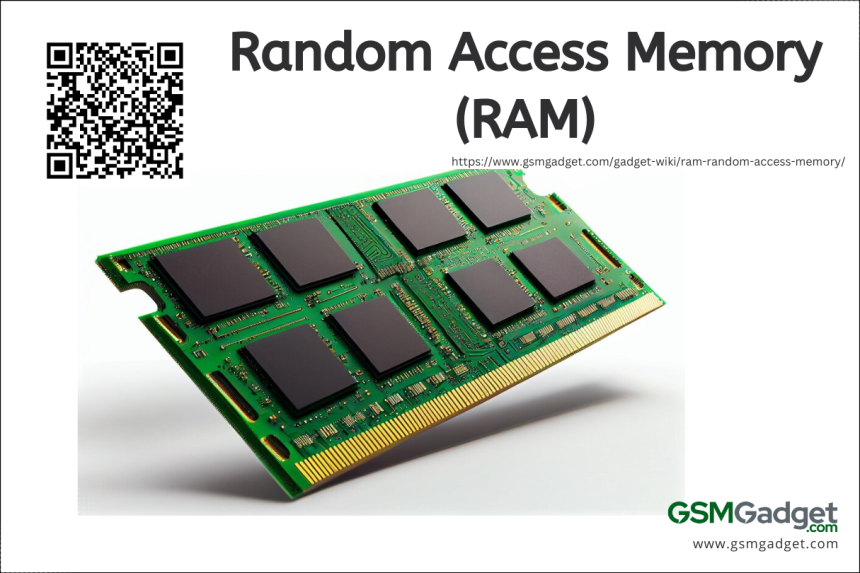Random Access Memory (RAM) is a crucial component in computing, serving as a computer’s short-term data storage. It enables the CPU to store and retrieve actively used data, providing rapid read and write access that is much faster than hard drives or solid-state drives. RAM is volatile, meaning it loses its data when power is turned off, in contrast to long-term storage options. The capacity and speed of RAM are vital to a computer’s performance, as more RAM allows multiple programs to run simultaneously and process data quickly, ensuring efficiency and a responsive user experience. Magnetic RAM (MRAM) is a type of RAM that offers non-volatility, low energy consumption, and fast switching speeds, making it a potential replacement for traditional CMOS-based memory and enhancing the capabilities of RAM in modern computing.
Technical Specifications of RAM
| Specification | Description |
| Type | DDR4, LPDDR4, LPDDR4X, LPDDR5 |
| Capacity | 2GB, 4GB, 6GB, 8GB, 12GB, 16GB and more |
| Speed | Measured in MHz, typically ranging from 2133 MHz to 5500 MHz for LPDDR5 |
| Bandwidth | The rate of data transfer; higher for LPDDR5 compared to its predecessors |
| Voltage | Power consumption; lower in LPDDR4X and LPDDR5 for energy efficiency |
| Channels | Single, dual, or multi-channel; more channels mean better performance |
| CAS Latency | The delay time between the memory controller requesting data from the RAM and the available data; lower is faster |
| Architecture | 64-bit or 32-bit; 64-bit supports more capacity and is faster |
| Compatibility | Compatibility with the processor and the motherboard |
| Form Factor | The physical size and pin configuration of the RAM module |
| Features | Additional features like ECC (Error Correcting Code) for data integrity |
History of RAM
The evolution of RAM demonstrates the technological advancements in computing since the early 1940s. Initially utilizing Williams tubes, the earliest electronic digital computers quickly transitioned to magnetic-core memory in the 1950s. The semiconductor revolution of the late 1960s brought about metal-oxide-semiconductor (MOS) memory chips, with Intel’s introduction of the first commercial DRAM chip in 1970 representing a significant advancement. DRAM became the industry standard due to its high density and cost-effectiveness compared to SRAM, and has since dominated the market for many years. RAM technology has continued to progress, with milestones such as Synchronous DRAM in the 1990s and the subsequent development of DDR SDRAM further improving performance. Recent innovations, like ferroelectric NonVolatile RAM in the 1980s initially aimed at military applications before transitioning to commercial use, and Magnetic RAM, offer nonvolatility, low energy consumption, and durability, suggesting future advancements in spin-transfer torque technology. Today, the exponential growth in capacity and reduction in size of RAM remain essential for the rapid data access needed for complex computing tasks.
Types of RAM (Random Access Memory)
Random Access Memory (RAM) serves as the primary short-term memory in computers, temporarily storing information to enable quick access by the processor. This is crucial for improving the speed and efficiency of computer operations. Advancements in technology have led to the development of various types of RAM, each with distinct characteristics and capabilities to meet different computer needs. An examination of the common types of RAM reveals how each contributes to the optimal performance of modern devices.

1. Dynamic random access memory (DRAM)
Dynamic Random Access Memory (DRAM) is a widely used type of RAM known for its rapid data access and is essential in numerous electronic devices, ranging from personal computers to gaming systems. DRAM is selected for its cost-effectiveness and simple design; it stores data in individual capacitors within an integrated circuit, requiring regular power refreshes – hence the term “dynamic”. This configuration allows for greater memory capacity, enabling DRAM components to store large amounts of data, which is crucial for the primary memory requirements of a computer system. Despite being typically slower and more energy-intensive than Static RAM (SRAM), its combination of affordability and compact size positions it as a key component of system memory in various computing devices, underscoring its indispensable role in the realm of electronics.
2. Static random access memory (SRAM)
Static Random Access Memory (SRAM) is a type of memory known for its speed and reliability, making it ideal for applications requiring rapid data access. Unlike Dynamic RAM (DRAM), which requires frequent refreshing to maintain data integrity, SRAM retains data as long as power is supplied due to its stable flip-flop design, typically consisting of six transistors per bit. This configuration ensures data stability and eliminates the need for constant refreshing. The fast access times of SRAM are utilized in short-term memory within CPUs, hard drive buffers, and networking equipment to reduce data retrieval times, thereby enhancing overall processor performance. While SRAM offers superior speed and reliability compared to DRAM, it is also more expensive and energy-intensive due to its intricate design, leading to its limited use in applications where performance is critical.
3. Synchronous dynamic random access memory (SDRAM)
Synchronous Dynamic Random Access Memory (SDRAM) is a type of RAM that operates in synchronization with the system clock, resulting in improved data signal quality and system stability. Its design includes a resistor module, mode register, decoder, and logic control module, all of which work together to enhance performance in integrated systems. Unlike older asynchronous RAM, SDRAM performs tasks in coordination with clock signals, allowing for increased data capacity and faster performance. It anticipates when data will be available, enabling more efficient command handling during each clock cycle. Evolving from SDRAM, Double Data Rate (DDR) technology transmits data on both the rising and falling edges of the clock signal, effectively doubling the data transfer rate without requiring a faster clock speed. Subsequent versions such as DDR2, DDR3, and DDR4 offer faster speeds, increased capacity, and improved power efficiency, making them essential components in modern computers for facilitating rapid and seamless data exchange between the RAM and the CPU.
4. Extended data output random-access memory (EDO RAM)
Extended Data Output Random-Access Memory (EDO RAM) represented a significant advancement in RAM technology during the mid-1990s, surpassing the capabilities of Fast Page Mode (FPM) RAM. By extending the duration of memory output data lines during each access cycle, EDO RAM enabled tasks to overlap and reduced the wait time between consecutive memory reads. This increased efficiency allowed CPUs to access data more quickly, offering a cost-effective performance boost for computers prior to the widespread adoption of Synchronous Dynamic RAM (SDRAM). Despite being replaced by newer memory technologies, EDO RAM played a crucial role in the evolution of computer memory, providing tangible benefits without requiring substantial hardware changes.
5. Rambus dynamic random-access memory (RDRAM)
Rambus Dynamic Random-Access Memory (RDRAM) is a type of high-speed computer memory developed by Rambus Inc. in the mid-1990s. It was designed to offer faster and more efficient performance compared to standard Synchronous Dynamic Random-Access Memory (SDRAM). RDRAM featured a unique architecture that allowed it to process data at twice the speed by utilizing both the rising and falling edges of the clock signal, enabling a higher data throughput without increasing the clock speed. However, RDRAM required a specialized Rambus memory slot and was primarily utilized for demanding tasks such as 3D graphics and video editing. Despite its performance advantages, RDRAM faced challenges due to its high cost, heat generation, and additional fees, leading to limited adoption. The introduction of Double Data Rate Synchronous Dynamic Random-Access Memory (DDR SDRAM) later offered comparable speed at a lower cost and power consumption, ultimately leading to the decline and discontinuation of RDRAM in the early 2000s.
Difference between RAM and ROM
Random Access Memory (RAM) and Read-Only Memory (ROM) are essential components of a computer, each serving distinct functions. RAM is volatile, meaning it loses its data when the computer is powered off. It functions as a temporary memory space for immediate information access and processing, enabling quick read and write operations crucial for program execution and efficient task performance. In contrast, ROM is non-volatile, retaining its data even without power. It is utilized to store fundamental instructions necessary for booting up the computer. The data in ROM is programmed during manufacturing and is not intended to be frequently altered. While RAM provides the computer with rapid data access, ROM preserves critical startup instructions, making both types of memory vital for optimal computer operation and stability.
Uses of Random Access Memory (RAM)
Random Access Memory (RAM) is a vital form of temporary memory in computers and electronic devices. It serves as a rapid workspace for the operating system, programs, and current data. RAM’s primary function is to facilitate quick reading and saving operations, thereby enhancing the speed and efficiency of software. By enabling swift access to necessary information, RAM allows the computer to perform tasks smoothly and quickly, ensuring efficient operation. This component is essential for ensuring optimal performance and multitasking capabilities in a computer system.

1. Temporary storage location
A key component of phones and computers, random access memory (RAM) functions as a quick temporary storage space that has a big impact on system speed. It enables the processor to quickly access and manage program instructions and data, facilitating multitasking by keeping relevant information readily available for quick retrieval. Due to its volatile nature, RAM is ideal for storing data temporarily while the device is powered on, ensuring smooth operation. The amount of RAM in a device directly correlates to its ability to handle complex tasks and large amounts of data, making it essential for optimal performance in computers and other technological devices.
2. Possible to read files faster
The speedy opening and manipulation of files is made possible by Random Access Memory (RAM), which is crucial for improving a computer’s speed and performance. When a file is opened, its data is transferred from the slower hard drive or solid-state drive to the RAM, allowing the CPU to access it more rapidly. Due to its fast read and write capabilities, RAM enables swift retrieval and modification of data. A computer with ample RAM capacity can temporarily store more information, reducing the need to constantly retrieve data from slower storage devices. This enables the computer to efficiently multitask and provides a seamless user experience. Immediate access to data not only accelerates file opening but also aids in executing demanding computer tasks and running memory-intensive applications, which are crucial for optimal computer performance.
3. Improves application performance
As the fundamental memory of the computer, Random Access Memory (RAM) is a crucial part of computers that improves application performance. It enables rapid access and modification of data, which is crucial for the CPU to efficiently execute programs. This is particularly important in modern devices, which are becoming smaller yet still require high-performance capabilities for tasks such as artificial intelligence, online storage, and internet connectivity for everyday devices. RAM’s quick read and write speeds, in comparison to storage devices like hard drives or SSDs, facilitate multitasking and efficient processing of complex programs. Therefore, having an adequate amount of RAM is vital for maintaining fast computer performance, immediate task completion, and overall effectiveness, especially when handling demanding workloads.
4. System Stability
Random Access Memory (RAM) serves as the primary temporary storage space for operating systems and applications, playing a critical role in maintaining system stability. By providing adequate workspace for the processor, RAM enables efficient handling of multiple tasks and reduces the likelihood of system crashes and slowdowns. Sufficient RAM ensures rapid data retrieval, preventing bottlenecks and eliminating the need for frequent data swapping with slower hard drives or solid-state drives. This efficiency results in a smooth, stable user experience and increased productivity, particularly when running resource-intensive programs. Ample RAM is essential for creating a reliable computing environment where processes can run concurrently without sacrificing performance.
5. Multitasking
In order to multitask, a computer needs Random Access Memory (RAM), which offers quick data storage. With ample RAM, computers can efficiently handle multiple tasks and programs simultaneously, quickly accessing and storing data. This capability reduces reliance on slower hard drives, minimizing wait times and preventing slowdowns. As a result, users experience minimal delays when switching between tasks and can work effectively even when background processes are running. In summary, sufficient RAM transforms a computer into a high-speed data center, ensuring optimal performance for memory-intensive programs.
